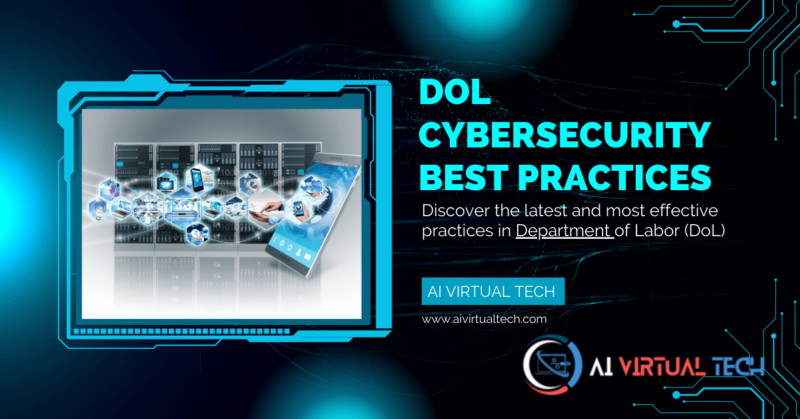Discover the latest and most effective practices in Department of Labor (DoL) cybersecurity to ensure the utmost protection of your valuable data and critical infrastructure. Gain invaluable insights into implementing robust security measures that safeguard the integrity and confidentiality of your sensitive information. Stay ahead of potential threats and maintain a secure environment for your organization’s digital assets.
Understanding DoL Cybersecurity
- DoL cybersecurity best practices are not merely guidelines; they are robust measures aimed at securing sensitive data and the overall IT infrastructure.
- Organisations must prioritise the understanding and implementation of these practices to safeguard their systems.
- This involves a holistic approach that includes not just technical safeguards, but also employee awareness and training.
- The first step towards achieving robust cybersecurity is understanding the threat landscape. This includes being aware of potential vulnerabilities in your system, the different types of cyber threats, and the potential impacts of a security breach. Knowledge is, indeed, the first line of defense in cybersecurity.
- Implementing DoL cybersecurity best practices involves continuous learning and adaptation. Cyber threats are continually evolving, and so must your security measures.
- Regularly updating your knowledge and staying informed about the latest cyber threats and defense mechanisms is crucial.
Essential DoL Cybersecurity Practices
One of the pivotal DoL cybersecurity best practices involves implementing strong access control measures.
Access to sensitive data and IT systems should be restricted and managed to prevent unauthorized access.
Implementing strong password policies, two-factor authentication, and limited privilege access are some ways to achieve this.
Regular system audits are another essential part of DoL cybersecurity best practices. These audits help identify potential system vulnerabilities and verify the effectiveness of implemented security measures. They are a proactive approach towards maintaining the integrity of your IT systems and data.
Training employees about cybersecurity is another crucial practice. Employees should be made aware of potential cyber threats, how to identify them, and the steps to take if they suspect a security breach. This empowers employees to act as an additional line of defense against cyber threats.
Incorporating Encryption Techniques
- Encryption is a powerful tool in the arsenal of DoL cybersecurity practices. It involves transforming data into a format that can only be understood by someone who possesses the appropriate decryption key.
- There are two primary types of encryption: symmetric and asymmetric. Symmetric encryption uses the same key for encryption and decryption, while asymmetric encryption uses different keys.
- Both these encryption methods play a pivotal role in maintaining data security during transit and at rest.
- The application of encryption extends beyond just data. It can also be used to secure network traffic, email communications, and files. Implementing encryption may vary in complexity depending on the size and nature of the data being secured, but its benefits in enhancing data security are well worth the effort.
- Encryption can help meet compliance requirements. Many regulations and standards emphasize the importance of encrypting sensitive data to prevent unauthorized access. Therefore, using encryption not only protects your data but also plays a significant role in regulatory compliance.
Regular Software Updates and Patch Management
Regular software updates and patch management are integral to DoL cybersecurity best practices.
Updates often come with patches that fix vulnerabilities within the software. These vulnerabilities, if left unpatched, could provide an entry point for cyber threats.
Software updates are not limited to just the operating system. They should also be performed for all installed applications, as they can also be targeted by cybercriminals.
Regular updates ensure that you have the latest security enhancements and fixes for known vulnerabilities.
Patch management is the process of managing updates across all systems in your network. It involves identifying, acquiring, installing, and verifying patches for your IT systems.
A well-executed patch management process can significantly reduce the attack surface and protect your systems from known vulnerabilities.
Implementing Network Security Measures
- Implementing robust network security measures is another essential DoL cybersecurity practice.
- Network security involves implementing policies and practices to prevent unauthorized access, misuse, modification, or denial of a computer network and its network-accessible resources.
- Firewalls, Intrusion Detection Systems (IDS), Intrusion Prevention Systems (IPS), Virtual Private Networks (VPNs), and network segmentation are some of the tools and techniques used in network security. These tools inspect the traffic entering and leaving your network and block any suspicious activities.
- Network security also involves monitoring and analyzing network traffic to identify any potential threats or anomalies.
- Network security tools can provide real-time alerts in case of any suspicious activities, allowing for prompt response and mitigation of threats.
Developing a Cybersecurity Incident Response Plan
Having a well-defined incident response plan is a vital part of DoL cybersecurity best practices.
An incident response plan outlines the steps to be taken in the event of a cybersecurity incident to effectively manage and mitigate its impact.
The first step in developing an incident response plan is identifying potential cyber threats and assessing the risks associated with them.
The plan should include procedures for detecting, analyzing, containing, eradicating, and recovering from incidents.
The incident response plan should also define roles and responsibilities of the incident response team.
This team would be responsible for responding to the incident, documenting the event and its impact, and implementing corrective measures. Regular testing and updating of the incident response plan is essential to ensure its effectiveness.

Emphasizing User Awareness and Education
- User awareness and education form the cornerstone of effective cybersecurity. Employees, as end-users of IT systems, are often the targets of cyberattacks.
- Phishing scams, for instance, trick employees into exposing sensitive data or access credentials. Employee ignorance or negligence often leads to successful cyberattacks.
- Creating a security-aware culture requires regular and comprehensive training. Employees need to understand the importance of cybersecurity, the common threats they might face, and how to respond in the event of a security incident. This information should be communicated in a way that is easy to understand and apply.
- To training, awareness initiatives like posters, newsletters, and security advisories can be used to reinforce the cybersecurity message.
- Regularly testing employees’ knowledge and understanding of cybersecurity can also be effective.
- The goal is to create a security-aware culture where cybersecurity becomes second nature to every employee.
Summary
In the contemporary digital era, cybersecurity is of paramount importance. This document gives an overview of the best practices, emphasizing the significance of an Incident Response plan, and the necessity of User Awareness and Education as the backbone of cybersecurity. The Incident Response plan outlines the procedures for managing incidents and defines the roles of an Incident Response Team. It emphasizes regular updates to ensure effectiveness. User Awareness and Education are underscored as crucial elements in curbing cyberattacks. The document highlights the need for comprehensive training, awareness campaigns, and routine testing to build a secure culture.
Frequently Asked Questions (FAQS)
Q: What is the purpose of an Incident Response Plan?
A: The Incident Response Plan outlines the procedures for detecting, analyzing, containing, eradicating, and recovering from incidents. It also defines the roles and responsibilities of the Incident Response Team.
Q: Who is responsible for implementing corrective measures in the event of a cybersecurity incident?
A: The Incident Response Team is responsible for responding to the incident, documenting the event and its impact, and implementing corrective measures.
Q: Why is User Awareness and Education important in cybersecurity?
A: User Awareness and Education are important because employees are often the targets of cyberattacks. Training and awareness initiatives equip employees with the knowledge on how to respond in the event of a security incident.
Q: What are some of the ways to enhance User Awareness and Education?
A: Apart from regular and comprehensive training, other initiatives like posters, newsletters, and security advisories can be used to reinforce the cybersecurity message. Regularly testing employees’ knowledge and understanding of cybersecurity can also be effective.
Q: What is the ultimate goal of promoting User Awareness and Education in cybersecurity?
A: The ultimate goal is to create a security-aware culture where cybersecurity becomes second nature to every employee.
Conclusion
In conclusion, cybersecurity is a shared responsibility that requires collective efforts. The implementation of an effective Incident Response Plan and the promotion of User Awareness and Education are key strategies towards enhancing cybersecurity. Regular updates and knowledge testing are necessary to keep pace with evolving cyber threats. The ultimate goal is to instill a security-aware culture, where cybersecurity is embedded into the daily operations of each employee.













